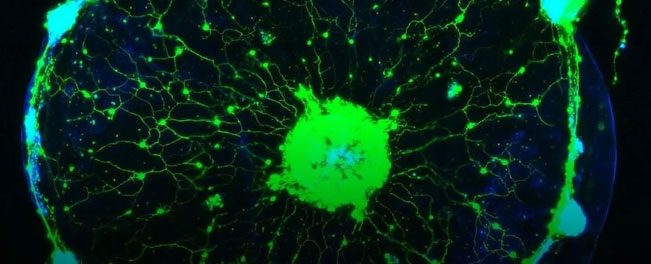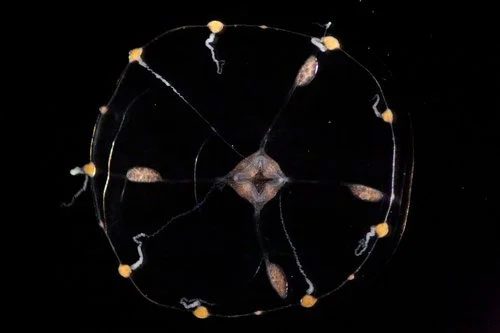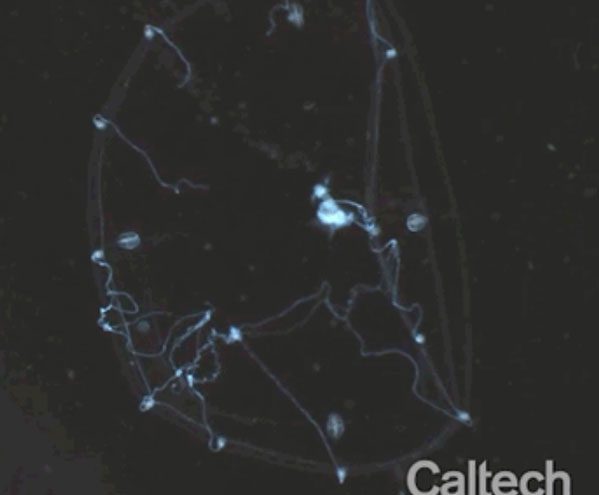Although jellyfish lack a brain, scientists have discovered a way to read their thoughts.
With a slight genetic modification, we can now track how the neurons inside the transparent jellyfish operate to create complex autonomous movements (catching and consuming prey).
The jellyfish species Clytia hemisphaerica (C. hemisphaerica) is the perfect specimen for research due to its small body size (only about one centimeter in diameter), allowing the entire nervous system to fit comfortably under a microscope.

C. hemisphaerica has a relatively simple genome.
C. hemisphaerica possesses a relatively simple genome, with its transparent body containing only about 10,000 neurons. This simplicity is advantageous for observation. Researchers genetically modified this jellyfish species so that its neurons would glow when activated, revealing “unpredictable levels of organized neural structure.”
The jellyfish’s nervous system evolved over 500 million years ago and has changed very little since then. Compared to the brains of modern animals, the neurons of these living fossils are arranged in a much simpler manner.
Without a central brain, how can jellyfish move or hunt?
Research shows that the neurons of C. hemisphaerica are organized in the shape of an umbrella, closely reflecting their body structure. These neurons are then divided into multiple segments, resembling slices of cake.
Each tentacle beneath the jellyfish’s bell connects to one of these slices. When a tentacle detects and captures prey, the neurons immediately activate in a specific sequence.

The neurons of C. hemisphaerica are organized in the shape of an umbrella.
First, the neurons at the edge slice send messages to the neurons in the center, which control the jellyfish’s mouth. This causes the edge slice to move the tentacles toward the jellyfish’s mouth while simultaneously directing the mouth toward the incoming food.
After familiarizing themselves with the prey, the brine shrimp (Artemia), researchers found that among 96% of the tested jellyfish that attempted to “transfer food,” 88% succeeded. Most brine shrimp were captured and consumed by creatures with such hunting methods.

This image depicts the edge slice of the jellyfish bending, bringing the shrimp toward its mouth.
To identify which type of neuron was activating this domino effect, researchers deleted a type of neuron called RFa+ from the edge slice. The results showed that the asymmetric bending within the jellyfish’s neurons did not occur, thereby failing the transfer of food from the tentacles to the mouth.
“RFa+ neurons are necessary for both the food-induced bending and the bending caused by experimental chemicals. In contrast, swimming and pulsing movements were not disrupted, indicating that another type of neuron controls that behavior,” the researchers stated.
To observe how the neurons controlling the jellyfish’s mouth coordinate with the neurons controlling the bell and vice versa, the research team surgically removed some body parts.
When the mouth was removed, the jellyfish continued to move food from the tentacles toward their nonexistent mouth. After cutting off several tentacles, they noticed that chemicals released from the shrimp could still activate the mouth to turn toward the food.
This research indicates that certain behaviors of jellyfish are governed by multiple groups of neurons with different functions, scattered around the periphery of the umbrella. For instance, the network of neurons connecting the bell and the mouth of the jellyfish may also connect to the digestive system.
When the jellyfish in the study were deprived of food, the research team observed that their tentacles moved faster to catch prey compared to when they were not hungry. This confirms that when hungry, certain neural responses inform the jellyfish that it needs to fill its digestive system, putting the parts responsible for foraging on high alert.
“If this hierarchical perspective is correct, coordinated behaviors in brainless organisms like jellyfish will emerge through mechanisms of replicating and modifying autonomous modular units to form super-modules capable of functional interaction. How such interactions are formed is a question that the scientific community is trying to elucidate,” the researchers hypothesized.





















































